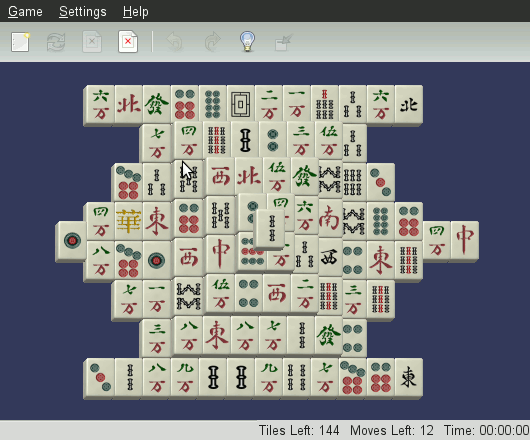



There is a board game called Mahjongg. It is said to have been invented in China; its rules are said to be complex. I have never played it. What I have played is the two versions for the computer: Mahjongg and Shisen-Sho. These are simple: find two stones that are the same and click on them to make them disappear. Keep doing this until all stones are gone. In Mahjongg, the difficulty is that stones are piled on top of each other, and only the outer stones may be removed; in Shisen-Sho, the whole board is filled with stones and they can only be removed if they are adjacent or on the outside and connectable with straight lines (a little hard to explain, but the game demonstrates when asked for a hint). There are four of each type of stone, so if the "wrong" two are removed, the other two may be forever unreachable as they lie hedged in or buried under other stones. There are also two quartets where the stones each have different pictures yet can be clicked away as pairs, usually with images of plants and seasons. The other stones differ from each other only subtly, so it's just as well that Mahjongg for the computer offers a choice of tilesets, so if one set gives me a headache from peering at it, I can choose a clearer one.
Mahjongg is to Linux distributions what Solitaire and other card games are to Windows versions; the average distribution has at least one version of it, with hints, tilesets and an undo function. This is the default layout ("Turtle") in the simple Mahjongg game included with Gnome:

Click here for an image of the KMahjongg "Castle" layout and "Imperial Jade" tileset, here for the configuration screen showing the many layouts in KMahjongg, here for the full Shisen-sho board (only one layout of course, but different tilesets) with a red line for the first hint, and here for that same board (and another hint line) after some playing. In this Shisen-Sho tileset, the stones that would have had one unique image each are simply blank. Finally, click here for the oldest, plainest Linux version I know of: xmahjongg.
The Gnome/KDE versions are skinnable. On various distros I've run into
variations of the Chinese tileset, an Egyptian hieroglyphics tileset, a
letters-and-numbers tileset and even a "pirate" theme.


